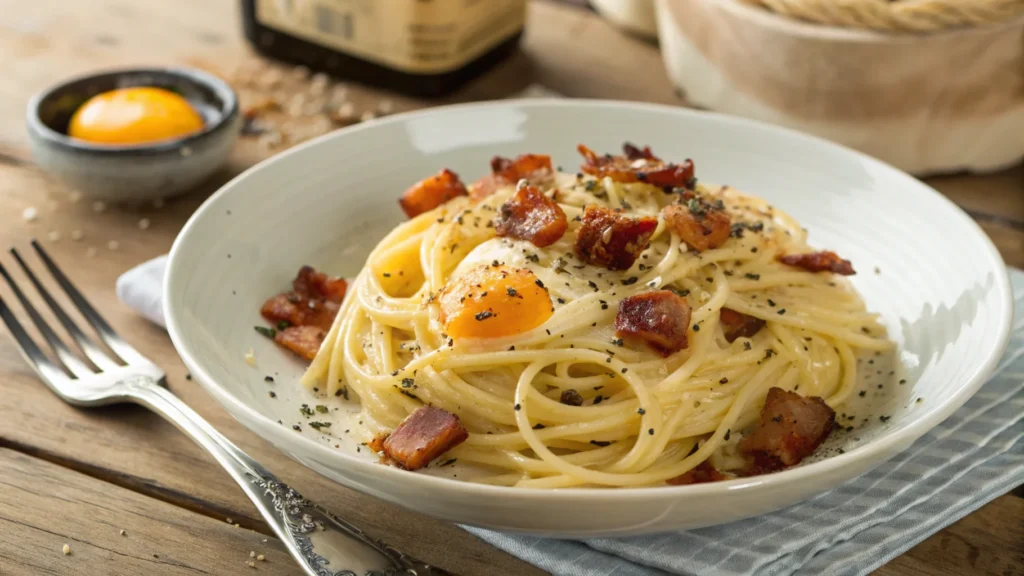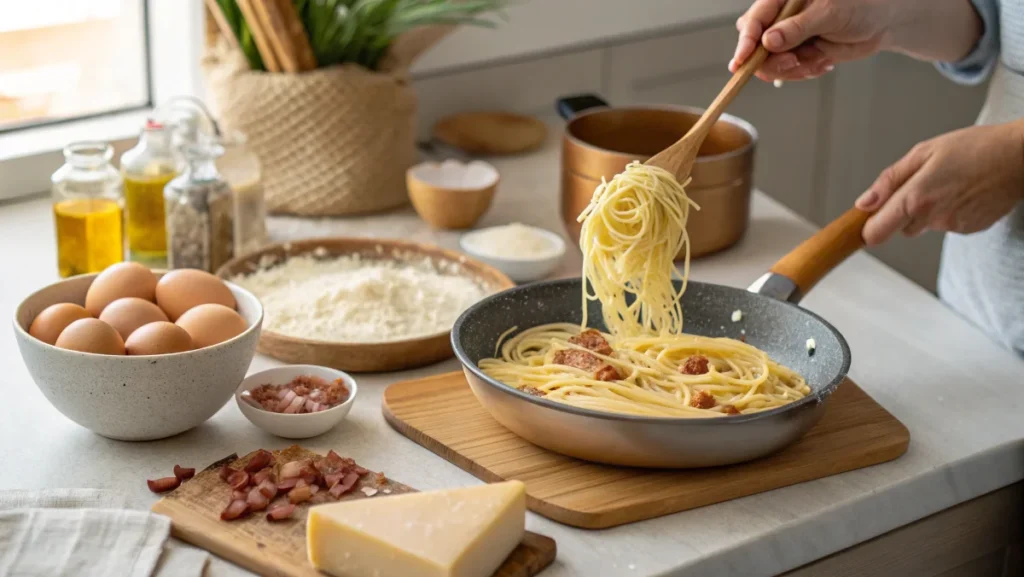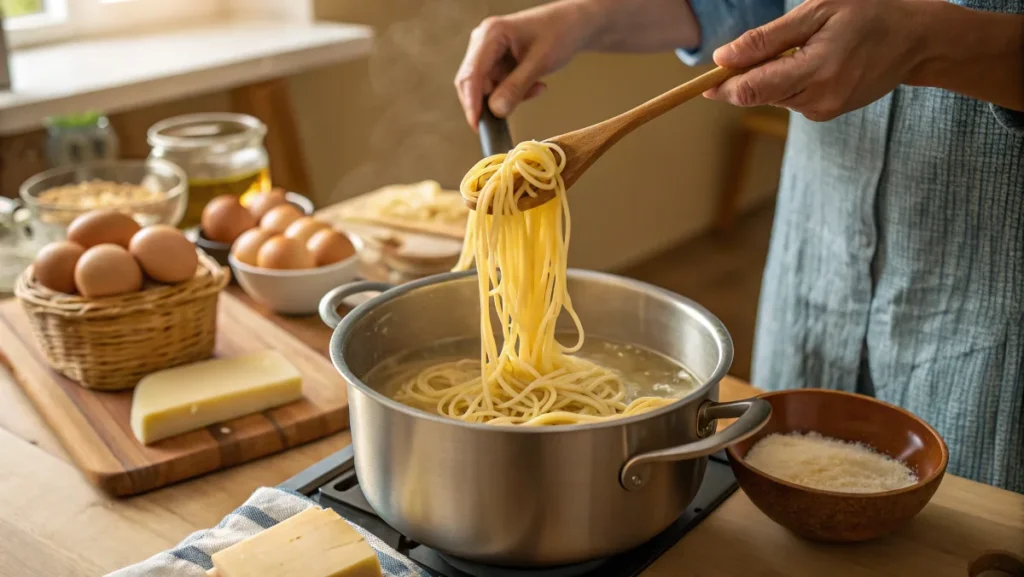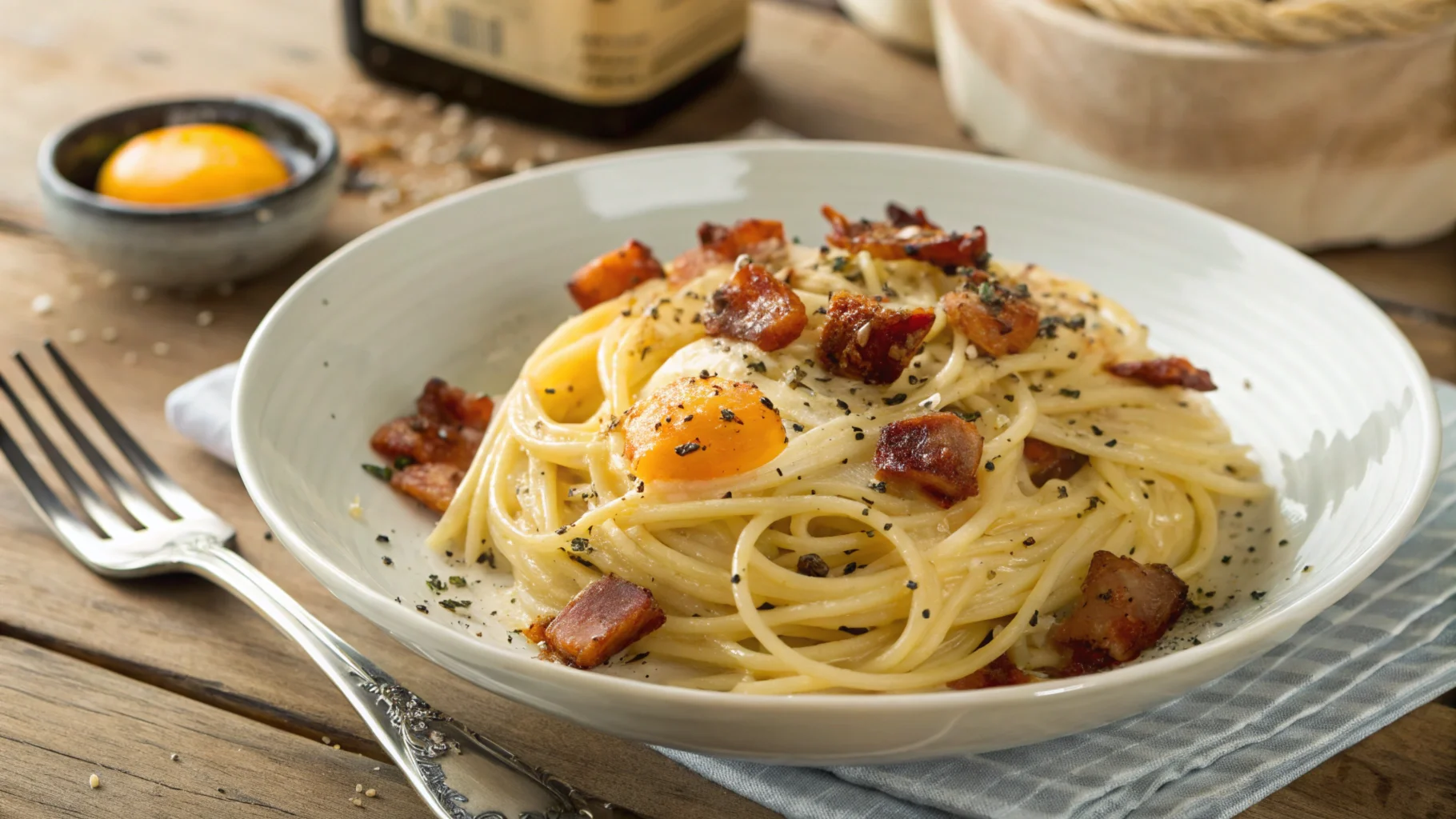Italian cuisine is known for rich flavors, fresh ingredients, and tradition. Pasta is a staple, with many dishes rooted in history. The 4 basic Italian pastas stand out for their simplicity and deep cultural ties, showcasing how a few ingredients can create amazing flavors. For those interested in exploring more romantic Italian dishes, consider trying Marry Me Pasta: A Deliciously Romantic Dish to Impress. This dish combines creamy sauces with sun-dried tomatoes, making it a perfect choice for a special dinner.
In this article, we will explore four iconic dishes: Spaghetti alla Carbonara, Pasta alla Gricia, Cacio e Pepe, and Pasta all’Amatriciana. We’ll also dive into their origins and variations. Additionally, we’ll show you how to make them at home. Along the way, we’ll discuss the art of Italian pasta making. You’ll learn how to pair these dishes with wine. Finally, we’ll look at the cultural impact these dishes have had worldwide.

Table of Contents
The Art of Italian Pasta Making
The art of making Italian pasta is a skill that has been passed down for centuries. Each region in Italy has its own way of making pasta, but the basics are always the same: fresh ingredients, simple techniques, and a love for tradition. Whether made by hand or with a machine, Italian pasta is at the heart of the country’s food culture.
Pasta dough is typically made from semolina flour and water. Some recipes may include eggs, especially in regions like Emilia-Romagna. Once you prepare the dough, roll it out. Then, cut it into various shapes, from thin strands of spaghetti to broad sheets of lasagna. Cooks often choose pasta shapes based on the sauce they will pair with.
Interestingly, the method of cooking pasta is just as important as its preparation. Italians typically cook pasta al dente (firm to the bite), which helps maintain its texture and allows it to better absorb sauces. This principle is essential when preparing any of the four pasta dishes we’re about to explore.

Spaghetti alla Carbonara
Spaghetti alla Carbonara is a beloved Italian pasta dish. With simple ingredients—spaghetti, eggs, pecorino, guanciale, and black pepper—it creates a rich, flavorful meal. As one of the 4 basic Italian pastas, it highlights how basic ingredients come together to make something truly special.
The Origins of Carbonara
Although the exact origin is debated, many believe Spaghetti alla Carbonara started in Rome in the mid-20th century. Some think Italian coal miners (carbonari) made it using simple, easy-to-carry ingredients. Others believe American soldiers in Italy during World War II helped shape the dish by adding bacon and eggs to local food.
How to Make Carbonara
Making Spaghetti alla Carbonara is simple but requires care to get the right texture. First, cook the guanciale—an Italian cured meat from pork cheek—until it’s crispy. Then, whisk together eggs and pecorino cheese to make a creamy sauce. Once the pasta is cooked and drained, mix it with the egg and cheese mixture, which creates a smooth, rich coating. Finally, add freshly cracked black pepper to give a nice contrast to the creamy dish.
In essence, Spaghetti alla Carbonara exemplifies the Italian philosophy of making something spectacular out of few, simple ingredients. It’s all about timing, the quality of the ingredients, and getting the pasta just right.
Pasta alla Gricia
Another Roman classic, pasta alla gricia, is often referred to as the “pre-carbonara” because it shares many of the same ingredients—guanciale, pecorino romano, and black pepper. However, unlike carbonara, this dish doesn’t include eggs. Instead, the fat rendered from the guanciale mixes with the pecorino romano to create a rich, savory sauce.
Typically, pasta alla gricia is made with rigatoni or tonnarelli, which are both ideal for holding the sauce. The large ridges of rigatoni allow the sauce to cling to the pasta, offering a satisfying texture with every bite.
This dish highlights the beauty of simplicity, relying on the quality of the ingredients to shine. As such, it’s a great example of how the best Italian pasta dishes use minimal ingredients but still deliver bold, satisfying flavors.
Cacio e Pepe
Cacio e pepe is a classic Roman pasta dish that demonstrates how a few ingredients can create something magical. The name literally means “cheese and pepper,” and that’s exactly what this dish is about: pecorino romano cheese and black pepper combine with pasta water to form a creamy, smooth sauce.
The key to making cacio e pepe is in the technique. The pasta must be cooked al dente, and the starchy pasta water must be used to help the cheese emulsify into a smooth sauce. The pecorino romano provides the richness, while the freshly cracked black pepper gives the dish its signature bite.
This dish exemplifies the Italian philosophy of transforming basic ingredients into something extraordinary. When done right, cacio e pepe is an incredibly satisfying pasta dish with a perfect balance of creamy, spicy, and savory flavors.
Pasta all’Amatriciana
No discussion of Italy’s pasta dishes is complete without Pasta all’Amatriciana. With its rich tomato sauce, crispy guanciale, and tangy pecorino romano, this dish is unforgettable. Typically made with spaghetti or buccatini, it’s one of the 4 basic Italian pastas that highlight Italy’s culinary tradition.
The Origins of Amatriciana
Pasta all’Amatriciana originates from the town of Amatrice in central Italy. The dish was traditionally made with guanciale, tomatoes, and pecorino, and has been enjoyed for centuries. There’s even a historical rivalry between Rome and Amatrice over the true origin of the dish, with each claiming to have created it first.
Making Pasta all’Amatriciana
To make Pasta all’Amatriciana, the guanciale is first rendered until crispy. Next, add tomatoes to the pan and simmer them to form a rich sauce. Cook the pasta al dente, then toss it in the sauce to absorb all the flavors. Finally, sprinkle grated pecorino on top, adding creaminess and a sharp contrast to the richness of the guanciale. This dish is an example of how Italians have perfected the art of combining simple ingredients to create bold and layered flavors.
Common Threads in the 4 Main Pasta Dishes
While each of the four pasta dishes we’ve explored has its own unique character, there are several common elements that bind them together. These common threads reflect the simplicity and richness that characterize traditional Italian cooking.
- Guanciale: This cured pork cheek is a key ingredient in three out of the four dishes. It imparts a savory, umami-rich flavor that forms the backbone of the sauces.
- Pecorino Romano: This sharp sheep’s milk cheese is featured in all four dishes, providing a salty, tangy counterpoint to the richness of the meat and sauces.
- Minimalist Approach: Each dish uses only a handful of ingredients, relying on their quality and technique to elevate the flavors.
- Roman Influence: Most of these dishes hail from Rome, showcasing the city’s culinary impact on Italian cuisine.
These commonalities highlight the timelessness and adaptability of these dishes across generations.

Variations on the Classics
Although people still love the original recipes for Spaghetti alla Carbonara, Pasta alla Gricia, Cacio e Pepe, and Pasta all’Amatriciana, many variations and adaptations have emerged over the years. Chefs and home cooks alike have added their own twists to these iconic dishes, often based on regional preferences or available ingredients.
- Carbonara: Some variations use bacon instead of guanciale, or substitute parmesan for pecorino. Additionally, some cooks experiment with adding cream, though this is controversial in traditional Roman cooking.
- Gricia: Some versions use pancetta instead of guanciale, and different pasta shapes like fusilli or penne are sometimes chosen based on personal preference.
- Cacio e Pepe: While the traditional version uses only pecorino romano and black pepper, some variations include a sprinkle of parmesan for a different flavor profile or even add butter for extra creaminess.
- Amatriciana: While tomatoes are a key ingredient, some versions omit the tomato and focus more on the guanciale and pecorino, which makes for a richer, more savory sauce.
These variations often reflect personal tastes, but the core principles of simplicity and quality ingredients remain unchanged.
Cultural Impact of These Pasta Dishes
The four pasta dishes we’ve discussed—Spaghetti alla Carbonara, Pasta alla Gricia, Cacio e Pepe, and Pasta all’Amatriciana—are not only staples of Italian cuisine but are also part of the 4 basic Italian pastas that have had a significant cultural impact. Each dish carries with it centuries of history and tradition, and they continue to be enjoyed by people around the world.
These pasta dishes serve as a reminder of the importance of simplicity in cooking. Despite their global popularity, these dishes are a reflection of Italian culture, where the focus is on using high-quality ingredients and honoring culinary traditions.
Additionally, these pasta dishes have inspired countless adaptations and interpretations by chefs outside Italy, further spreading the influence of Italian cuisine. Whether served in a local trattoria in Rome or at an Italian restaurant halfway across the world, these pasta dishes bring people together, creating a shared connection to Italian culture and gastronomy.
How to Choose the Right Ingredients
The success of any Italian pasta dish lies in the ingredients. When making Spaghetti alla Carbonara, Pasta alla Gricia, Cacio e Pepe, or Pasta all’Amatriciana—some of the 4 basic Italian pastas—the quality of the guanciale, pecorino romano, and the pasta itself is paramount.
- Guanciale: Always choose guanciale instead of pancetta or bacon, as it gives a unique flavor and texture that others can’t match.
- Pecorino Romano: Opt for an authentic pecorino romano that is aged and packed with flavor. Avoid pre-grated cheese, as it tends to lack the sharpness and creaminess that freshly grated cheese offers.
- Pasta: Use high-quality dried pasta, such as gragnano pasta, which is made from durum wheat and is ideal for holding sauce.
By sourcing high-quality ingredients, you ensure that your dish will have the authentic flavors that are central to these traditional pasta recipes.
Tips for Making These Italian Pasta Types at Home
Making these pasta dishes at home can be a rewarding experience. Here are some tips to help you get perfect results:
- Timing is crucial: Cook your pasta al dente, as it will absorb the sauce better and provide the best texture.
- Don’t overcook the meat: Whether you’re using guanciale or bacon, be sure not to overcook it. The goal is to render the fat and achieve crispiness without burning.
- Embrace the pasta water: Use reserved pasta cooking water to adjust the consistency of your sauce. The starch in the water helps thicken and bind the sauce.
- Keep it simple: Avoid overcomplicating the dish. The beauty of these pasta dishes lies in their simplicity, so stick to the traditional ingredients and methods.
By following these tips, you’ll be able to recreate authentic Italian pasta dishes in your own kitchen.
FAQs: Italian Pasta Types
What Are the 4 Basic Italian Pastas?
The four basic Italian pastas are:
- Spaghetti – Long, thin noodles.
- Fettuccine – Flat, wide noodles.
- Penne – Tubular pasta.
- Rigatoni – Large, ridged tubes.
These staples form the base for many classic Italian dishes.
What Are the Top 4 Pasta Dishes in Rome?
The top 4 pasta dishes in Rome are:
- Spaghetti alla Carbonara – Eggs, guanciale, and pecorino romano.
- Pasta alla Gricia – Guanciale and pecorino, no eggs or tomatoes.
- Cacio e Pepe – Pecorino romano and black pepper.
- Pasta all’Amatriciana – Tomato sauce, guanciale, and pecorino romano.
These iconic dishes define Roman cuisine.
What Is the Most Popular Pasta Dish in Italy?
The most popular pasta dish in Italy is Spaghetti alla Carbonara, known for its creamy texture and savory flavors of guanciale and pecorino romano.
What Are the 4 Classifications of Pasta?
Pasta is typically classified into four types:
- Pasta Lunga – Long pasta like spaghetti.
- Pasta Corto – Short pasta like penne.
- Pasta Ripiena – Stuffed pasta like ravioli.
- Pasta Fatta in Casa – Homemade pasta like tagliatelle.
Conclusion: The 4 Basic Italian Pastas
Italian pasta dishes are the epitome of simplicity, flavor, and tradition. Dishes like Spaghetti alla Carbonara, Pasta alla Gricia, Cacio e Pepe, and Pasta all’Amatriciana are some of the 4 basic Italian pastas that have stood the test of time, remaining beloved by both locals and food enthusiasts worldwide. Each dish tells a story of Italy’s rich culinary heritage and its emphasis on fresh, quality ingredients. For those who enjoy discovering the finer details of cuisine, exploring dishes like Flat Iron Steak: Why It’s More Expensive and Worth It | Tender, Juicy, and Flavorful can provide deeper insights into the craftsmanship and care behind exceptional culinary creations.
When you understand the origins, techniques, and key ingredients behind these dishes, you can appreciate them even more. Whether you’re enjoying them at an Italian restaurant or preparing them in your own kitchen, these classic pasta dishes offer a true taste of Italy’s culinary soul.

